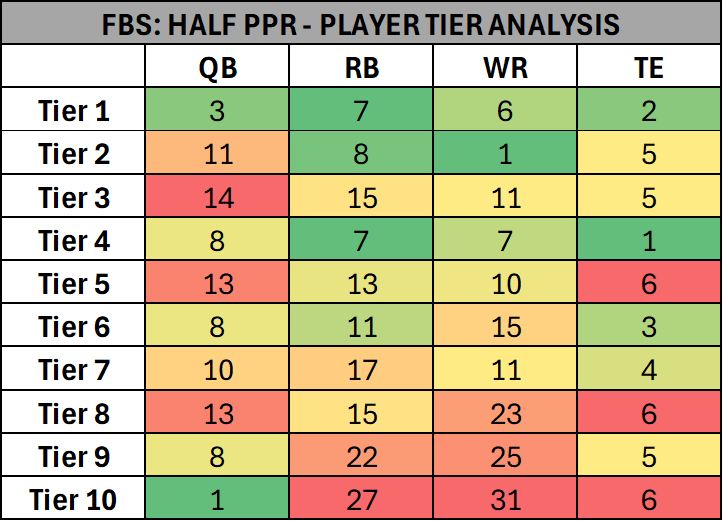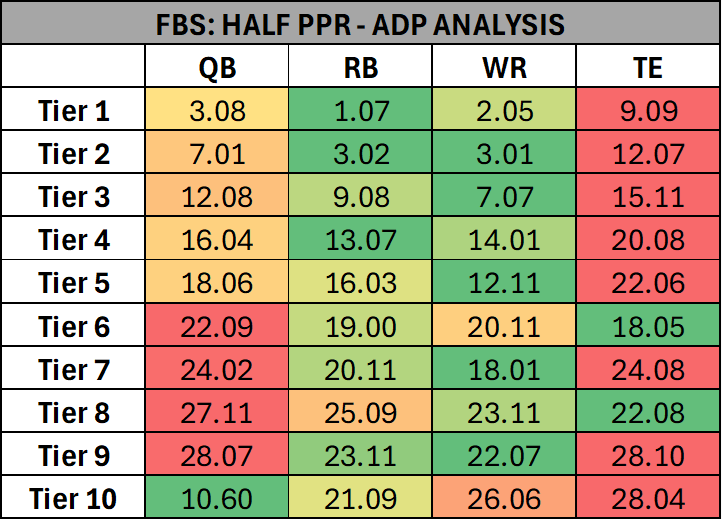Purple Reign must start by pointing out there is no “one way” to approach drafting a CFF team. This guide represents the strategy I have come up with after reviewing the 2025 player pool. You can follow this guide to the letter, or incorporate ideas into the draft strategy you already use. It is purely up to the reader how to use this information.
TIER ANALYSIS
I assign players into tiers based on several pieces of criteria. I start with the fantasy point projection I have made for the player within the specific scoring format. I then review the player’s position battle status and move players down the more uncertain that position battle status is. Then finally I review the profile I have assigned for that player. Players are moved down again based on the level of fantasy production potential.
Tiers go from 1 being the best, then counting their way downward. I consider all players from a position group in the same tier can be viewed as “equal” which allows a drafter to select the player that they like best.
Once I have finished my first round of player rankings I look at how many players from each position group are in each tier. This gives you a feel for how much depth, or lack thereof you can find at different position groups. Green represents rarity while red represents abundance. I’ve only included the top 10 tiers in this breakdown. This information will also help you determine which positions to focus on or wait for during the draft.
Quarterback: With the abundance of tier 2-3 QBs you can skip the tier 1 guys. Landing two tier 2-3 guys would be great but if you can’t you need to lock down a tier 4 guy. Tiers 5-6 should be where you really want to flush out your bench, while looking to tiers 7-8 for your final QB roster spot. You’ll have to pick your spots to prioritize QB over RB & WR.
Running Back: The tier 1-2 RBs should be a top priority in the early rounds of the draft. Once you fall into tier 3-4 you can switch to focusing on QB & WR in spots. Grab your tier 3 guys since tier 4 drops off significantly. Once you hit Tier 5 the number of players in each tier continues to grow. This means you can loosen up on the RB position if you hammered it early in the draft.
Wide Receiver: There are not many tier 1-2 players available and I recommend grabbing one of those players. The pool of WRs grow in tier 3 where you should grab at least one WR. With tier 4 being smaller than the remaining tiers, this should be a priority area. Focus on not letting all the tier 6-7 players disappear, and once they do there’s tons of WRs in tiers 8+ that you can wait until the end of the draft.
Tight End: Just like QB I would avoid tier one, and jump into tiers 2-3 aggressively. Grab one TE from that range then you can wait until tier 5 to start filling in back-ups. The tiers stay pretty evenly spread out once tier 5 starts.
ADP ANALYSIS
Its extremely important to have an understanding of when players are being taken in drafts. ADP (Average Draft Position) is the tool used to assess this. I’ve pulled the ADP data from the end of June to use for this analysis. I’ve pulled the average ADP for all players within a tier for this review. Since I have players in tiers that are over-valued and under-valued, you will see players drafted earlier and later than these average numbers. The ADP data listed in this article is the average round & draft pick, with 1.01 presenting the first pic of the first round. Green represents the earliest average draft pick for a specific tier, while red represents the latest average draft pick.
Quarterback: If you’re going to be aggressive in getting a tier 2-3 QB you’ll need to make a move in rounds 6-13. The tier 4-5 guys aren’t much later, so you might get 1-2 other positions drafted before pivoting back to QB. You can then wait until the early to mid-twenty rounds to circle back to the position.
Running Back: The top two tiers of RBs will vanish very fast. Grab 1-2 of them before pivoting back by at least round 5. Tiers 3-4 should be mostly gone by round 15, then you’ll continue to see tiers 5-7 going off the board. Once you enter hit round 20 focus on finishing off your RB roster before drafting any other players.
Wide Receiver: If you want to get a tier 1-2 WR you’ll have to do it in the first two rounds. Once that run ends, you can wait until round 6 to circle back to the position. You need to make a commitment to grab at least one tier 3 WR, before coming back to get a tier 4-5 WR in the early teen rounds. The end of the teen rounds should be used to play catch-up at WR before you make the shift to RBs in round 20.
Tight End: Let other owners start the TE run but be ready to strike as soon as the first tier 2 player is drafted. Tiers 2-3 can go quickly in the early to mid-teen rounds, and once that well runs dry there’s no need to circle back until round 18. At that point you should be aggressive looking for tier 4-6 TEs unless you want to wait for your bench. If that’s the case you could wait until the mid-twenty rounds to do so.
CONCLUSION
Roster Breakdown: QB-6, RB-10, WR-10, TE-4
Rounds 1-2: 1 RB tier 1-2, WR tier 1-2
Rounds 3-5: 1 QB tier 2, 2 RB tier 2-3
Rounds 6-10: 1 QB tier 2-3, 2 RB tier 3-4, 2 WR tier 3-4
Rounds 11-15: 1 QB tier 3-4, 1 RB tier 4-5, 2 WR tier 4-6, 1 TE tier 2-3
Rounds 16-20: 2 QB tier 4-6, 2 RB tier 5-7, 1 WR tier 6-8
Rounds 21-25: 1 QB tier 6+, 2 RB tier 7+, 1 WR tier 8+, 1 TE tier 4+
Rounds 26-30: 3 WR, 2 TE (best available)







